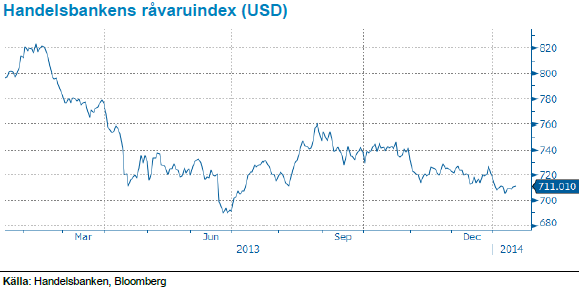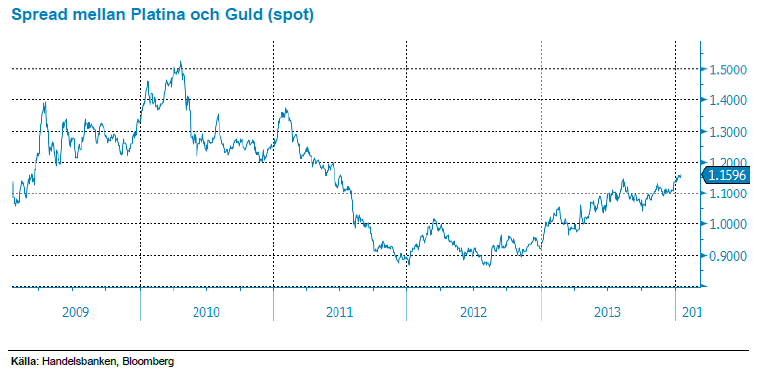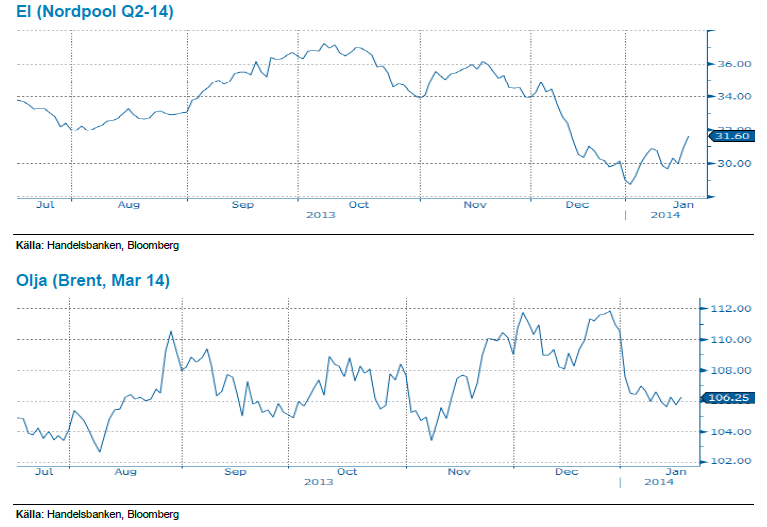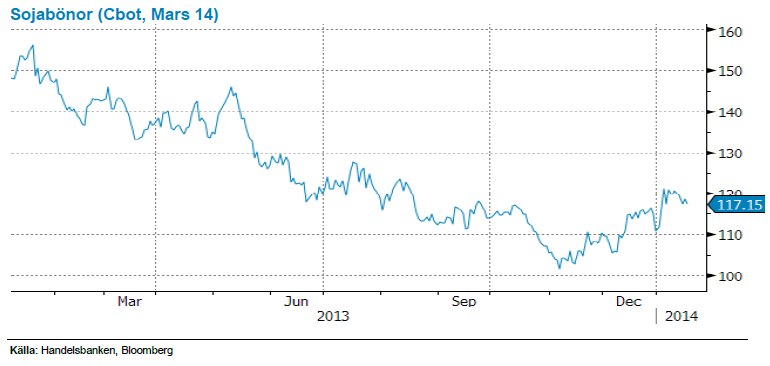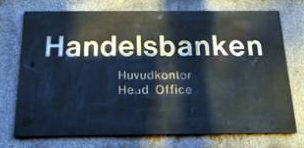Analys
SHB Råvarubrevet 17 januari 2014
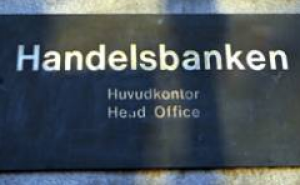
 Råvaror allmänt:
Råvaror allmänt:
Fokus på inflation i väntan på Kinas BNP siffra
All fokus på deflationstendenser i Europa och USA under veckan. USA data oroar inte även om förra fredagens arbetsmarknadsrapport var oväntat svag. Ärkekylan i Nordamerika har nog gett sitt bidrag till den siffran.
Istället fokuserar marknaden på den låga inflationen. Om den förblir låg trots att makrodata förbättras kommer sannolikt FED låta räntan ligga kvar på nuvarande låga nivåer vilket kan ge konjunkturen ytterligare skjuts. Även i Europa är inflationen låg. Inte minst fallande priser på livsmedelsråvaror har bidragit till det låga inflationstrycket som eventuellt kommer tvinga ECB till ytterligare aktioner. Nästa vecka, på måndag, kommer Kinas helårs BNP siffra, ingen stor sak enligt oss då det är tillrättalagd data. Kina kommer snart somna in i nyårsfirande under sista veckan i januari och som vanligt blir tiden därefter viktig för att ta ut riktningen för vårens utveckling på råvarumarknaden. Förra året kom aldrig Kina igång efter nyårsledigheten och vi minns ju alla hur råvarupriserna föll under fjolårets första halvår.
Basmetaller: Är verkligen metallmarknaden så väl försörjd?
En viktig kopparfråga inför 2014 är om gruvorna ska fortsätta klara sig med mindre driftstörningar än normalt? Så var fallet under 2013 och det var en av förklaringarna till att produktionen ökade med 9 % mot historiska snittet på 2,5 %. Speciellt under andra halvåret ökade gruvproduktionen och fick priset på fall. I början av detta år ser det mer positivt ut med en stark import av koppar till Kina.
Annars är nickel metallen med stort M just nu. Vi har hetsat upp oss över nickel sedan i december, baserat på låga prisnivåer, det nu lanserade exportstoppet av oförädlad nickelmalm från Indonesien och det faktum att 40 % av gruvorna går med förlust på dagens prisnivå (vår så kallade cocktail där exportstoppet är den starka ingrediensen). Situationen är inte hållbar och priset har nu stigit 5 dagar i rad. Världens metallanalytiker har snabbt delat upp sig i två läger; de som tror att historien snabbt passerar och de som tror att det blir långvarig påverkan på nickelmarknaden. Vi sällar oss som bekant till de senare. Ett tungt vägande skäl är sommarens val i Indonesien som riskerar att skapa en ordentlig soppa av en redan rörig situation kring exportförbudet och dess effekter som nu gör ca 1 miljon människor arbetslösa i Indonesien. Vi lär återkomma i ämnet.
Zink är en annan rallande basmetall. Fjolåret visar nu på ett oväntat underskott i marknaden där LME:s lager föll med 300 000 ton. Begränsningar i Kinas produktion, lägre produktion utanför Kina och en starkare efterfrågan under andra halvåret har bättrat på marknadsbalansen. Efter att en av de riktigt stora indexdrakarna nu slutat sälja zink efter ombalanseringen kring årsskiftet så har nu zink klättrat uppåt.
Vi tror sammantaget att basmetallerna kommer stiga några veckor till innan de åter vänder ned. Vi tror på: LONG BASMETALLER H
Ädelmetaller: Produktionsstörningar pressar upp platina
Vi lägger en ganska händelselös vecka för guldet till handlingarna, en marginell prisnedgång och tight range utan nya signaler eller nyheter. Vår negativa vy ligger kvar intakt, även om vi – som vi beskrev förra veckan – kan se möjligheter för den riskvillige och opportunistiske köparen. En av våra favorittrades från förra året kan vara smart i detta läge – lång platina mot guld. Denna beskrev vi helt kort i Börsrummet 17 juni, och denna spread har sedan början av 2013 stigit med nära 26 % (varav 12 % sedan den 17 juni…). Det betyder att platina blivit 26 % mer värt RELATIVT guldet, fast att även platina föll under 2013. Fördelen med en ”marknadsneutral” position i två olika ädelmetaller mot varandra är att man inte behöver riskera att sitta fel i en rekyl uppåt i guldpriset, även om man – som vi – är negativ till guldet.
Vårt resonemang kring guldet är numera bekant – man köper det bara för att sälja dyrare – medan platina är en ädelmetall som faktiskt behövs till något (främst katalysatorer till bilindustrin). Platina har dessutom brottats med produktionsstörningar i Sydafrika under året som gått.
Sättet att skapa sig en ”spreadposition” i dessa är att köpa – för lika mycket pengar – LONG PLAT H och SHRT GULD H. Genom att göra detta tar man en vy enbart på dessa ädelmetallers värdering relativt varandra, och man blir mindre exponerad mot en underliggande marknadsrörelse i ädelmetallsektorn.
Vi tror på mindre exponering mot en underliggande marknadsrörelse i ädelmetallsektorn. Vi tror på: Spreaden mellan LONG PLAT H och SHRT GULD H
Energi: Väderomslag stärker elpriset
Som vi skrev förra veckan har väderskiftet till kallare och torrare väder har drivit upp både spotpriset och terminspriser. Q2-14 (underliggande till SHB Power) har stigit med nästan 7 % under veckan. Det hydrologiska läget för norden har försämrats marginellt och ligger nu runt –2.8 TWh. Vi bedömer att energiunderskottet kommer att fortsätta öka på grund av betydligt högre lastnivå och en prognostiserad nederbörd under normalt.
Väderprognoser för Sverige och Norge för 10 dygn framåt visar på temperaturer på 2-3 grader under de normala. Nederbördsprognoserna visar på drygt 2.5 TWh under normalen för de kommande 10 dygnen. Det finns en god körvilja hos vattenkraftverken och vi har ett läge som inte stimulerar till allt för mycket sparande sett till spotpriset, vilket gör att vi tycker att närmaste kvartalskontrakten känns rätt värderade. Dock vill vi reservera oss för att om det kalla och torra vädret håller i sig under en längre period kan både spotpriset och terminskurvan justeras upp.
Oljepriset (brent) har pendlat runt 105-106 USD/fat under veckan och handlas i skrivande stund på USD 105,9.
Priset på Brent steg 1,5 % efter lagernivåer i USA föll mer än väntat, 7,66 miljoner fat mot väntade 0,67 miljoner. Vi har nu har de lägsta lagernivåerna på totalt 350,2 miljoner fat på 22 månader. USA:s stigande produktion fortsätter, driven av utvinning av skifferolja, och ligger nu på 8,16 miljoner fat per dag- detta att jämföra med Saudi Arabien (OPEC största producent) 9,68 mfpd. Ett avtal gällande Irans kärnprogram träder i kraft den 20 januari efter överenskommelse i förra veckan som bland annat innebär att Iran stoppar utvecklingen av kärnenergiprogram och anläggningar öppnas för inspektioner.
Vi tror att det kommer ges möjligheter till god avkastning i denna range-baserade handel där oljan är köpvärd var gång den kommer ned på dessa lite lägre nivåer. Vi tror på: LONG OLJA H
Livsmedel: Gynnsamt väder i Sydamerika
Priserna på majs i Chicago har gått ned under den gångna veckan, delvis påverkat av fallande priser på vete. En del regn har fallit i Argentina under veckan men klart mer behövs, främst i söder. Nästa vecka ser något bättre ut med mer regnperioder än torrperioder. Omkring 80 procent av sådden i Argentina uppges nu vara avklarad. Situationen har nu förbättrats något i Argentina och annars inga större problem att rapportera om varför det känns svårt att se varför majspriserna skulle vända uppåt.
Priserna i Chicago på sojabönor har stigit under veckan med stöd från fortsatt stark efterfrågan från Kina. Vädret i Sydamerika är generellt sett väldigt fördelaktigt och hoppet om en kommande rekordskörd stärks samtidigt som risken för bakslag blir allt mindre efter hand som skörden kommer närmare. 96 procent av den argentinska sådden uppges nu vara avklarad. Vad som ytterligare spär på tron om lägre priser på soja framöver är en förväntad stor areal i USA till våren – relationen mellan majspriser och sojapriser talar helt klart för en ökad areal soja på bekostnad av majs.
Stor skörd på ingång i Brasilien för sojabönor. Vi tror på: BEAR SOJA H
Handelsbankens råvaruindex
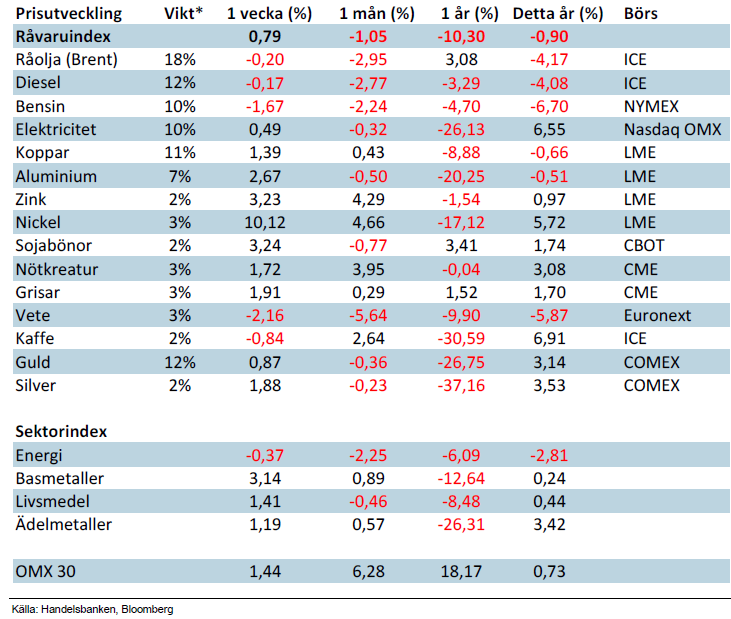
*Uppdaterade vikter från 29 november 2013
Handelsbankens råvaruindex består av de underliggande indexen för respektive råvara. Vikterna är bestämda till hälften från värdet av nordisk produktion (globala produktionen för sektorindex) och till hälften från likviditeten i terminskontrakten.
[box]SHB Råvarubrevet är producerat av Handelsbanken och publiceras i samarbete och med tillstånd på Råvarumarknaden.se[/box]
Ansvarsbegränsning
Detta material är producerat av Svenska Handelsbanken AB (publ) i fortsättningen kallad Handelsbanken. De som arbetar med innehållet är inte analytiker och materialet är inte oberoende investeringsanalys. Innehållet är uteslutande avsett för kunder i Sverige. Syftet är att ge en allmän information till Handelsbankens kunder och utgör inte ett personligt investeringsråd eller en personlig rekommendation. Informationen ska inte ensamt utgöra underlag för investeringsbeslut. Kunder bör inhämta råd från sina rådgivare och basera sina investeringsbeslut utifrån egen erfarenhet.
Informationen i materialet kan ändras och också avvika från de åsikter som uttrycks i oberoende investeringsanalyser från Handelsbanken. Informationen grundar sig på allmänt tillgänglig information och är hämtad från källor som bedöms som tillförlitliga, men riktigheten kan inte garanteras och informationen kan vara ofullständig eller nedkortad. Ingen del av förslaget får reproduceras eller distribueras till någon annan person utan att Handelsbanken dessförinnan lämnat sitt skriftliga medgivande. Handelsbanken ansvarar inte för att materialet används på ett sätt som strider mot förbudet mot vidarebefordran eller offentliggörs i strid med bankens regler.
Analys
Tightening fundamentals – bullish inventories from DOE

The latest weekly report from the US DOE showed a substantial drawdown across key petroleum categories, adding more upside potential to the fundamental picture.

Commercial crude inventories (excl. SPR) fell by 5.8 million barrels, bringing total inventories down to 415.1 million barrels. Now sitting 11% below the five-year seasonal norm and placed in the lowest 2015-2022 range (see picture below).
Product inventories also tightened further last week. Gasoline inventories declined by 2.1 million barrels, with reductions seen in both finished gasoline and blending components. Current gasoline levels are about 3% below the five-year average for this time of year.
Among products, the most notable move came in diesel, where inventories dropped by almost 4.1 million barrels, deepening the deficit to around 20% below seasonal norms – continuing to underscore the persistent supply tightness in diesel markets.
The only area of inventory growth was in propane/propylene, which posted a significant 5.1-million-barrel build and now stands 9% above the five-year average.
Total commercial petroleum inventories (crude plus refined products) declined by 4.2 million barrels on the week, reinforcing the overall tightening of US crude and products.
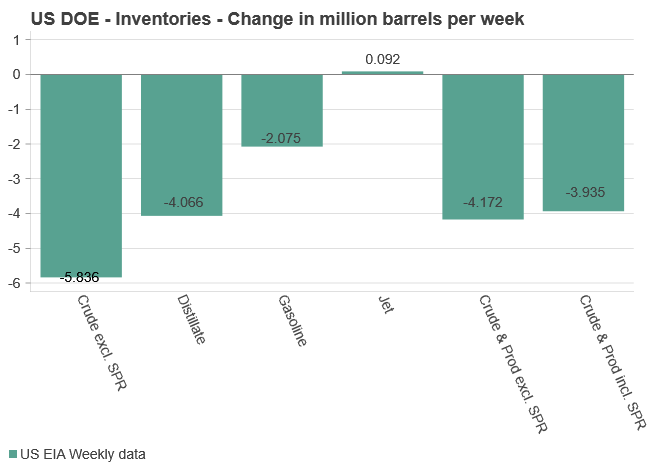
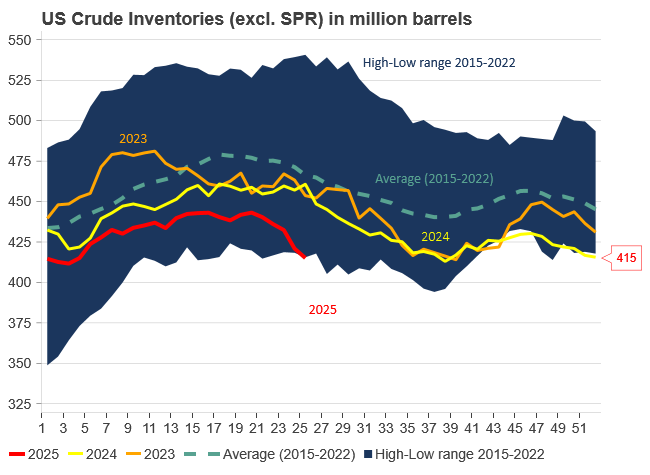
Analys
Bombs to ”ceasefire” in hours – Brent below $70

A classic case of “buy the rumor, sell the news” played out in oil markets, as Brent crude has dropped sharply – down nearly USD 10 per barrel since yesterday evening – following Iran’s retaliatory strike on a U.S. air base in Qatar. The immediate reaction was: “That was it?” The strike followed a carefully calibrated, non-escalatory playbook, avoiding direct threats to energy infrastructure or disruption of shipping through the Strait of Hormuz – thus calming worst-case fears.

After Monday morning’s sharp spike to USD 81.4 per barrel, triggered by the U.S. bombing of Iranian nuclear facilities, oil prices drifted sideways in anticipation of a potential Iranian response. That response came with advance warning and caused limited physical damage. Early this morning, both the U.S. President and Iranian state media announced a ceasefire, effectively placing a lid on the immediate conflict risk – at least for now.
As a result, Brent crude has now fallen by a total of USD 12 from Monday’s peak, currently trading around USD 69 per barrel.
Looking beyond geopolitics, the market will now shift its focus to the upcoming OPEC+ meeting in early July. Saudi Arabia’s decision to increase output earlier this year – despite falling prices – has drawn renewed attention considering recent developments. Some suggest this was a response to U.S. pressure to offset potential Iranian supply losses.
However, consensus is that the move was driven more by internal OPEC+ dynamics. After years of curbing production to support prices, Riyadh had grown frustrated with quota-busting by several members (notably Kazakhstan). With Saudi Arabia cutting up to 2 million barrels per day – roughly 2% of global supply – returns were diminishing, and the risk of losing market share was rising. The production increase is widely seen as an effort to reassert leadership and restore discipline within the group.
That said, the FT recently stated that, the Saudis remain wary of past missteps. In 2018, Riyadh ramped up output at Trump’s request ahead of Iran sanctions, only to see prices collapse when the U.S. granted broad waivers – triggering oversupply. Officials have reportedly made it clear they don’t intend to repeat that mistake.
The recent visit by President Trump to Saudi Arabia, which included agreements on AI, defense, and nuclear cooperation, suggests a broader strategic alignment. This has fueled speculation about a quiet “pump-for-politics” deal behind recent production moves.
Looking ahead, oil prices have now retraced the entire rally sparked by the June 13 Israel–Iran escalation. This retreat provides more political and policy space for both the U.S. and Saudi Arabia. Specifically, it makes it easier for Riyadh to scale back its three recent production hikes of 411,000 barrels each, potentially returning to more moderate increases of 137,000 barrels for August and September.
In short: with no major loss of Iranian supply to the market, OPEC+ – led by Saudi Arabia – no longer needs to compensate for a disruption that hasn’t materialized, especially not to please the U.S. at the cost of its own market strategy. As the Saudis themselves have signaled, they are unlikely to repeat previous mistakes.
Conclusion: With Brent now in the high USD 60s, buying oil looks fundamentally justified. The geopolitical premium has deflated, but tensions between Israel and Iran remain unresolved – and the risk of missteps and renewed escalation still lingers. In fact, even this morning, reports have emerged of renewed missile fire despite the declared “truce.” The path forward may be calmer – but it is far from stable.
Analys
A muted price reaction. Market looks relaxed, but it is still on edge waiting for what Iran will do

Brent crossed the 80-line this morning but quickly fell back assigning limited probability for Iran choosing to close the Strait of Hormuz. Brent traded in a range of USD 70.56 – 79.04/b last week as the market fluctuated between ”Iran wants a deal” and ”US is about to attack Iran”. At the end of the week though, Donald Trump managed to convince markets (and probably also Iran) that he would make a decision within two weeks. I.e. no imminent attack. Previously when when he has talked about ”making a decision within two weeks” he has often ended up doing nothing in the end. The oil market relaxed as a result and the week ended at USD 77.01/b which is just USD 6/b above the year to date average of USD 71/b.

Brent jumped to USD 81.4/b this morning, the highest since mid-January, but then quickly fell back to a current price of USD 78.2/b which is only up 1.5% versus the close on Friday. As such the market is pricing a fairly low probability that Iran will actually close the Strait of Hormuz. Probably because it will hurt Iranian oil exports as well as the global oil market.
It was however all smoke and mirrors. Deception. The US attacked Iran on Saturday. The attack involved 125 warplanes, submarines and surface warships and 14 bunker buster bombs were dropped on Iranian nuclear sites including Fordow, Natanz and Isfahan. In response the Iranian Parliament voted in support of closing the Strait of Hormuz where some 17 mb of crude and products is transported to the global market every day plus significant volumes of LNG. This is however merely an advise to the Supreme leader Ayatollah Ali Khamenei and the Supreme National Security Council which sits with the final and actual decision.
No supply of oil is lost yet. It is about the risk of Iran closing the Strait of Hormuz or not. So far not a single drop of oil supply has been lost to the global market. The price at the moment is all about the assessed risk of loss of supply. Will Iran choose to choke of the Strait of Hormuz or not? That is the big question. It would be painful for US consumers, for Donald Trump’s voter base, for the global economy but also for Iran and its population which relies on oil exports and income from selling oil out of that Strait as well. As such it is not a no-brainer choice for Iran to close the Strait for oil exports. And looking at the il price this morning it is clear that the oil market doesn’t assign a very high probability of it happening. It is however probably well within the capability of Iran to close the Strait off with rockets, mines, air-drones and possibly sea-drones. Just look at how Ukraine has been able to control and damage the Russian Black Sea fleet.
What to do about the highly enriched uranium which has gone missing? While the US and Israel can celebrate their destruction of Iranian nuclear facilities they are also scratching their heads over what to do with the lost Iranian nuclear material. Iran had 408 kg of highly enriched uranium (IAEA). Almost weapons grade. Enough for some 10 nuclear warheads. It seems to have been transported out of Fordow before the attack this weekend.
The market is still on edge. USD 80-something/b seems sensible while we wait. The oil market reaction to this weekend’s events is very muted so far. The market is still on edge awaiting what Iran will do. Because Iran will do something. But what and when? An oil price of 80-something seems like a sensible level until something do happen.
-

 Nyheter3 veckor sedan
Nyheter3 veckor sedanMahvie Minerals växlar spår – satsar fullt ut på guld
-

 Nyheter4 veckor sedan
Nyheter4 veckor sedanUppgången i oljepriset planade ut under helgen
-

 Nyheter4 veckor sedan
Nyheter4 veckor sedanLåga elpriser i sommar – men mellersta Sverige får en ökning
-

 Nyheter3 veckor sedan
Nyheter3 veckor sedanJonas Lindvall är tillbaka med ett nytt oljebolag, Perthro, som ska börsnoteras
-

 Analys3 veckor sedan
Analys3 veckor sedanA muted price reaction. Market looks relaxed, but it is still on edge waiting for what Iran will do
-

 Nyheter3 veckor sedan
Nyheter3 veckor sedanOljan, guldet och marknadens oroande tystnad
-

 Analys4 veckor sedan
Analys4 veckor sedanVery relaxed at USD 75/b. Risk barometer will likely fluctuate to higher levels with Brent into the 80ies or higher coming 2-3 weeks
-

 Nyheter3 veckor sedan
Nyheter3 veckor sedanDomstolen ger klartecken till Lappland Guldprospektering


